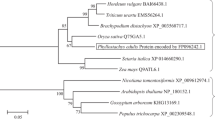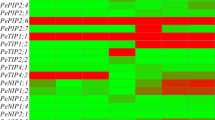Abstract
Key message
An aquaporin protein AcPIP2 from Atriplex canescens was involved in plant growth rate, abiotic stress tolerance in Arabidopsis. Under limited water condition, AcPIP2 leaded to the sensitivity to drought stress.
Abstract
An aquaporin protein (AcPIP2) was obtained from the saltbush Atriplex canescens, which was in PIP2 subgroup belonging to the PIP subfamily, MIP superfamily. The subcellular localization of AcPIP2 showed the fusion protein AcPIP2-eGFP located at the plasma membrane in Nicotiana benthamiana. Overexpression of AcPIP2 in Arabidopsis fully proved that AcPIP2 was involved in plant growth rate, transpiration rate and abiotic stress tolerance (NaCl, drought and NaHCO3) in Arabidopsis, which is mostly in correspondence to gene expression pattern characterized by qRT-PCR performed in A. canescens. And under limited water condition, AcPIP2 overexpression leaded to the sensitivity to drought stress. In the view of the resistant effect in transgenic Arabidopsis overexpressing AcPIP2, the AcPIP2 may throw some light into understanding how the A. canescens plants cope with abiotic stress, and could be used in the genetic engineering to improve plant growth or selective tolerance to the abiotic stress.









Similar content being viewed by others
Abbreviations
- AQPs:
-
Proteins called aquaporins
- MIPs:
-
Major intrinsic proteins
- TIPs:
-
Tonoplast intrinsic proteins
- PIPs:
-
Plasma membrane intrinsic proteins
- NIPs:
-
Noduline 26-like intrinsic membrane proteins
- SIPs:
-
Small basic intrinsic proteins
- PCR:
-
Polymerase chain reaction
- eGFP:
-
Enhance green fluorescent protein
- cDNA:
-
Complementary DNA
- MS:
-
Murashige and Skoog
- Hyg:
-
Hygromycin
- OE:
-
Overexpresser
- WT:
-
Wild-type
- VC:
-
Vector
- EF1α:
-
Elongation factor 1-alpha
- FW:
-
Fresh weight
- DW:
-
Dry weight
- WC:
-
Water contents
- ROS:
-
Reactive oxygen species
- SOD:
-
Superoxide dismutase
- NBT:
-
Nitroblue tetrazolium
References
Aharon R, Shahak Y, Wininger S, Bendov R, Kapulnik Y, Galili G (2003) Overexpression of a plasma membrane aquaporin in transgenic tobacco improves plant vigor under favorable growth conditions but not under drought or salt stress. Plant Cell 15:439–447
Aroca R, Amodeo G, Fernandez-Illescas S, Herman EM, Chaumont F, Chrispeels MJ (2005) The role of aquaporins and membrane damage in chilling and hydrogen peroxide induced changes in the hydraulic conductance of Maize roots. Plant Physiol 137:341–353
Ayarpadikannan S, Chung E, Cho CW, So HA, Kim SO, Jeon JM, Kwak MH, Lee SW, Lee JH (2011) Exploration for the salt stress tolerance genes from a salt-treated halophyte, Suaeda asparagoides. Plant Cell Rep 31:35–48
Benga G (2009) Water channel proteins (later called aquaporins) and relatives: past, present, and future. IUBMB Life 61:112–133
Benzarti M, Ben Rejeb K, Debez A, Abdelly C (2013) Environmental and economical opportunities for the valorisation of the genus Atriplex: new insights. In: Hakeem KR, Ahmad P, Ozturk M (eds) Crop improvement. Springer, New York, pp 441–457
Chowdhury SR, Choudhuri MA (1985) Hydrogen peroxide metabolism as an index of water stress tolerance in jute. Physiol Plant 65:476–480
Forrest KL, Bhave M (2007) Major intrinsic proteins (MIPs) in plants: a complex gene family with major impacts on plant phenotype. Funct Integr Genomics 7:263–289
Fujita M, Fujita Y, Noutoshi Y, Takahashi F, Narusaka Y, Yamaguchi-Shinozaki K, Shinozaki K (2006) Crosstalk between abiotic and biotic stress responses: a current view from the points of convergence in the stress signaling networks. Curr Opin Plant Biol 9:436–442
Guo L, Wang ZY, Lin H, Cui WE, Chen J, Liu M, Chen ZL, Qu LJ, Gu H (2006) Expression and functional analysis of the rice plasma-membrane intrinsic protein gene family. Cell Res 16:277–286
Heath RL, Packer L (1968) Photoperoxidation in isolated chloroplasts: I. kinetics and stoichiometry of fatty acid peroxidation. Arch Biochem Biophys 125:189–198
Jang J, Lee S, Rhee J, Chung G, Ahn S, Kang H (2007) Transgenic Arabidopsis and tobacco plants overexpressing an aquaporin respond differently to various abiotic stresses. Plant Mol Biol 64:621–632
Kammerloher W, Fischer U, Piechottka GP, Schiiffner AR (1994) Water channels in the plant plasma membrane cloned by immunoselection from a mammalian expression system. Plant J 6:187–199
Katsuhara M, Akiyama Y, Koshio K, Shibasaka M, Kasamo K (2002) Functional analysis of water channels in barley roots. Plant Cell Physiology 43:885–893
Katsuhara M, Koshio K, Shibasaka M, Hayashi Y, Hayakawa T, Kasamo K (2003) Overexpression of a barley aquaporin increased the shoot-root ratio and raised salt sensitivity in transgenic rice plants. Plant Cell Physiology 44:1378–1383
Kourie JI (1998) Interaction of reactive oxygen species with ion transport mechanisms. Am J Physiol Cell Physiol 275:C1–C24
Li L, Li S, Tao Y, Kitagawa Y (2000) Molecular cloning of a novel water channel from rice its products expression in Xenopus oocytes and involvement in chilling tolerance. Plant Sci 154:43–51
Li DD, Tai FJ, Zhang ZT, Li Y, Zheng Y, Wu YF, Li XB (2009) A cotton gene encodes a tonoplast aquaporin that is involved in cell tolerance to cold stress. Gene 438:26–32
Li J, Sun X, Yu G, Jia C, Liu J, Pan H (2014a) Generation and analysis of expressed sequence tags (ESTs) from halophyte Atriplex canescens to explore salt-responsive related genes. Int J Mol Sci 15:11172–11189
Li JT, Yu G, Sun XH, Jia CG, Du Q, Li QY, Pan HY (2014b) Modification of vectors for functional genomic analysis in plants. Genet Mol Res 13:7815–7825
Lian HL, Yu X, Ye Q, Ding XS, Kitagawa Y, Kwak SS, Su WA, Tang ZC (2004) The role of aquaporin RWC3 in drought avoidance in rice. Plant Cell Physiology 45:481–489
Liu Y, Wang L, Xing X, Sun L, Pan J, Kong X, Zhang M, Li D (2013) ZmLEA3, a multifunctional group 3 LEA protein from Maize (Zea mays L.), is involved in biotic and abiotic stresses. Plant Cell Physiol 54:944–959
Mao X, Zhang H, Qian X, Li A, Zhao G, Jing R (2012) TaNAC2, a NAC-type wheat transcription factor conferring enhanced multiple abiotic stress tolerances in Arabidopsis. J Exp Bot 63:2933–2946
Martinez-Ballesta MC, Carvajal M (2014) New challenges in plant aquaporin biotechnology. Plant Sci 217–218:71–77
Matus J, Ferrier T, Riechmann J (2014) Identification of Arabidopsis knockout lines for genes of interest. In: Development Flower (ed) Riechmann JL, Wellmer F. Springer New, York, pp 347–362
Nogueira FTS, Rosa VED, Menossi M, Ulian EC, Arruda P (2003) RNA expression profiles and data mining of sugarcane response to low temperature. Plant Physiol 132:1811–1824
Pandey P, Senthil-Kumar M, Mysore K (2015) Advances in plant gene silencing methods. In: Mysore KS, Senthil-Kumar M (eds) Plant gene silencing. Springer, New York, pp 3–23
Sakurai J, Ishikawa F, Yamaguchi T, Uemura M, Maeshima M (2005) Identification of 33 rice aquaporin genes and analysis of their expression and function. Plant Cell Physiol 46(9):1568–1577
Sales AD, Lobo CH, Carvalho AA, Moura AA, Rodrigues APR (2013) Structure, function, and localization of aquaporins: their possible implications on gamete cryopreservation. Genet Mol Res 12:6718–6732
Shanker AK, Maheswari M, Yadav SK, Desai S, Bhanu D, Attal NB, Venkateswarlu B (2014) Drought stress responses in crops. Funct Integr Genomics 14:11–22
Shao Y, Guan Y, Wang L, Qiu Z, Liu M, Chen Y, Wu L, Li Y, Ma X, Liu M, Li D (2014) CRISPR/Cas-mediated genome editing in the rat via direct injection of one-cell embryos. Nat Protoc 9:2493–2512
Shi J, Fu XZ, Peng T, Huang XS, Fan QJ, Liu JH (2010) Spermine pretreatment confers dehydration tolerance of citrus in vitro plants via modulation of antioxidative capacity and stomatal response. Tree Physiol 30:914–922
Sun XH, Yu G, Li JT, Jia P, Zhang JC, Jia CG, Zhang YH, Pan HY (2014a) A heavy metal-associated protein (AcHMA1) from the halophyte, Atriplex canescens (Pursh) Nutt., confers tolerance to iron and other abiotic stresses when expressed in Saccharomyces cerevisiae. Int J Mol Sci 15:14891–14906
Sun Y, Yan F, Cui X, Liu F (2014b) Plasticity in stomatal size and density of potato leaves under different irrigation and phosphorus regimes. J Plant Physiol 171:1248–1255
Thomashow MF (2001) So what’s new in the field of plant cold acclimation? Lots! Plant Physiol 125:89–93
Törnroth-Horsefield S, Wang Y, Hedfalk K, Johanson U, Karlsson M, Tajkhorshid E, Neutze R, Kjellbom P (2006) Structural mechanism of plant aquaporin gating. Nature 439:688–694
Wang W, Vinocur B, Altman A (2003) Plant responses to drought, salinity and extreme temperatures: towards genetic engineering for stress tolerance. Planta 218:1–14
Wang C, Jing R, Mao X, Chang X, Li A (2010) TaABC1, a member of the activity of bc 1 complex protein kinase family from common wheat, confers enhanced tolerance to abiotic stresses in Arabidopsis. J Exp Bot 62:1299–1311
Wang J, Sun PP, Chen CL, Wang Y, Fu XZ, Liu JH (2011) An arginine decarboxylase gene PtADC from Poncirus trifoliata confers abiotic stress tolerance and promotes primary root growth in Arabidopsis. J Exp Bot 62:2899–2914
Yang L, Ji W, Gao P, Li Y, Cai H, Bai X, Chen Q, Zhu Y (2012) GsAPK, an ABA-activated and calcium-independent SnRK2-Type kinase from G. soja, mediates the regulation of plant tolerance to salinity and ABA stress. PLoS One 7(3):e33838
Zhang X, Henriques R, Lin SS, Niu QW, Chua NH (2006) Agrobacterium-mediated transformation of Arabidopsis thaliana using the floral dip method. Nat Protoc 1:641–646
Zhang Y, Li Y, Lai J, Zhang H, Liu Y, Liang L, Xie Q (2011) Ectopic expression of a LEA protein gene TsLEA1 from Thellungiella salsuginea confers salt-tolerance in yeast and Arabidopsis. Mol Biol Rep 39:4627–4633
Zhu C, Schraut D, Hartung W, Schäffner AR (2005) Differential responses of maize MIP genes to salt stress and ABA. J Exp Bot 56:2971–2981
Acknowledgments
This work was supported by grants of the 12th Five-Year Plan Project of Science and Technology Support, China (2012BAD19B04, 2014BAD14B02), and by the Research and Development of Industrial Technology Special at Jilin Provincial Development and Reform Commission (2013C001), and by the Ministry of Agriculture Key Project of GM Cultivation of New Varieties (2013ZX08004004), P. R. China, and by the Project 2014119 Supported by Graduate Innovation Fund of Jilin University.
Conflict of interest
The authors declare that they have no conflict of interest.
Author information
Authors and Affiliations
Corresponding author
Additional information
Communicated by H. Ebinuma.
J. Li and G. Yu contributed equally to this work.
Electronic supplementary material
Below is the link to the electronic supplementary material.
Rights and permissions
About this article
Cite this article
Li, J., Yu, G., Sun, X. et al. AcPIP2, a plasma membrane intrinsic protein from halophyte Atriplex canescens, enhances plant growth rate and abiotic stress tolerance when overexpressed in Arabidopsis thaliana . Plant Cell Rep 34, 1401–1415 (2015). https://doi.org/10.1007/s00299-015-1796-7
Received:
Revised:
Accepted:
Published:
Issue Date:
DOI: https://doi.org/10.1007/s00299-015-1796-7




